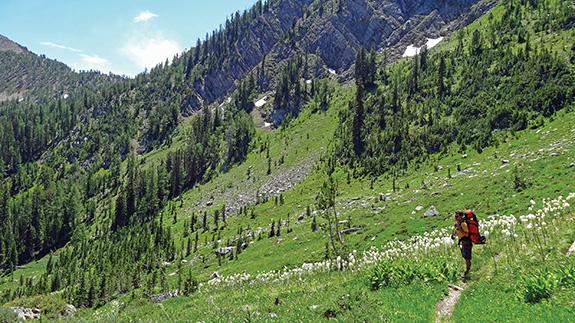Divided We Hike
Backpacking the CDT in Montana.
The Continental Divide Trail (CDT) is the longest and most remote of the three Triple Crown Trails, the other two being the Pacific Crest Trail and the Appalachian Trail.
Stretching 3,100 miles start to finish, the CDT begins at the Mexico-U.S. border and winds its way north through New Mexico, Colorado, Wyoming, Idaho, and Montana, finishing at the Montana-Canada border at Waterton Lake.
Beginning near West Yellowstone, the CDT straddles the Idaho-Montana border along Montana’s southwestern edge, turns west at Lost Trail, and then heads north through Montana before finishing in Glacier National Park. The Montana-only section begins at Chief Joseph Pass and is just under 800 miles long, much of which is incredibly secluded and challenging. Here’s how to get started planning this section of the CDT.
Montana Section Southern Terminus: The CDT stays in Montana beginning at Chief Joseph Pass, 30 miles south of Darby.
Northern Terminus: US-Canada border at Waterton Lake in Glacier National Park.
Timeline
The roughly 800 miles through Montana will take most fit hikers 8-10 weeks. Starting in early July will put you in a good spot to finish before winter weather comes through the higher elevations up north. Regardless of when you start, aim to finish by the end of September.
Highlights
Anaconda-Pintler Wilderness: The 45 miles of CDT through the Anaconda-Pintler Wilderness feature a multitude of branching options to access alpine lakes, trout streams, and epic peaks. The climbs and descents are rugged, but the views from the high passes and summits are worth it.
Bob Marshall Wilderness: This stretch is one of the most popular segments for section-hiking the CDT. The main feature of this section is the Chinese Wall, the base of which the CDT traverses along for nearly five miles. Thru-hikers will see plenty of horse-packers and section-hikers who will likely have food to share.
Glacier National Park: The Glacier section of the trail runs the final 100 or so miles to the Northern Terminus, and is one of the most stunning sections of the entire CDT. Backcountry camping regulations apply throughout Glacier, so be prepared with permits and know the rules.

Closest Towns
Resupplying throughout the Montana CDT section is possible with some easy hitches. Most long-distance hikers aim to carry no more than 5-7 days of food at a time, so plan accordingly and know your caloric needs. Below are a few suggestions for towns to hitch into for resupply, along with the best access point.
-Darby, via Lost Trail Pass
-Butte, via Homestake Pass
-Helena, via MacDonald Pass
-Lincoln, via Rogers Pass
-East Glacier Village
Additional Beta
-The Continental Divide Trail Coalition (CDTC) is the CDT’s governing nonprofit. The organization has a plethora of hike options for different sections and trail-crew trips, along with advice for gear, resupply, and timing.
-While much of the CDT is blazed and signed, route-finding and interpretation will be necessary at different points throughout the trail. Carry a map and GPS and know how to use them.
-Thru-hike the Montana section in the summer, but prepare for nights dipping below freezing. A three-season setup will work fine, but be ready for anything the high country in Montana can throw at you.
-Proper food storage and bear awareness is imperative through the entirety of the CDT through Montana. Seriously—don’t get lazy.
-Late-summer wildfires often reroute thru-hikers, so check in often once fire season has started. Land-management agencies will be able to suggest alternative routes.
Maggie Slepian thru-hiked the Appalachian Trail in 2015 and is the managing editor of thetrek.com.









